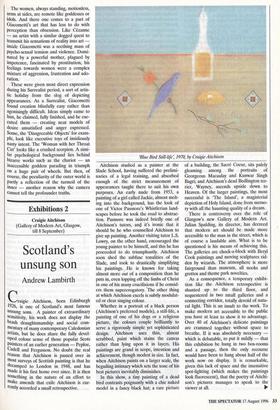Exhibitions 2
Craigie Aitchison (Gallery of Modem Art, Glasgow, till 8 September)
Scotland's unsung son
Andrew Lambirth
Craigie Aitchison, born Edinburgh 1926, is one of Scotland's most famous unsung sons. A painter of extraordinary sensitivity, his work does not display the brash draughtsmanship and social com- mentary of many contemporary Caledonian artists, but he does share the fully devel- °ped colour sense of those popular Scots Painters of an earlier generation — Peploe, Cade11 and Fergusson. No doubt the real reason that Aitchison is passed over in most surveys of Scottish painting is that he decamped to London in 1948, and has made it his first home ever since. it is then something in the nature of an effort to make amends that exile Aitchison is cur- rently accorded a small retrospective.
Blue Bird Still-life', 1970, by Craigie Aitchison
Aitchison studied as a painter at the Slade School, having suffered the prelimi- naries of a legal training, and absorbed enough of the strict measurement of appearances taught there to suit his own purposes. An early nude from 1953, a painting of a girl called Jackie, almost melt- ing into the background, has the look of one of Victor Pasmore's Whistlerian land- scapes before he took the road to abstrac- tion. Pasmore was indeed briefly one of Aitchison's tutors, and it's ironic that it should be he who counselled Aitchison to give up painting. Another visiting tutor L.S. Lowry, on the other hand, encouraged the young painter to be himself, and this he has proceeded to do triumphantly. Aitchison soon shed the subfuse tonalities of the Slade, and took to drastically simplifying his paintings., He is known for taking almost more out of a composition than he puts in, even lopping off the limbs of Christ in one of his many crucifixions if he consid- ers them supererogatory. The other thing at which Aitchison excels is subtly modulat- ed or clear singing colour.
Whether in a portrait of a black person (Aitchison's preferred models), a still-life, a painting of one of his dogs or a religious picture, the colours couple brilliantly to serve a rigorously simple yet sophisticated design. Aitchison uses thin, almost scrubbed, paint which stains the canvas rather than lying upon it in layers. His paintings are grand in scope, intention and achievement, though modest in size. In fact, when Aitchison paints on a larger scale, the beguiling intimacy which sets the tone of his best pictures inevitably diminishes.
In this show, a tiny painting of a dead bird contrasts poignantly with a chic naked model in a fancy black hat; a rare picture of a building, the Sacre Coeur, sits palely gleaming among the portraits of Georgeous Macaulay and Kunwar Singh Bagri; and Aitchison's dead Bedlington ter- rier, Wayney, ascends upside down to Heaven. Of the larger paintings, the most successful is 'The Island', a magisterial depiction of Holy Island, done from memo- ry with all the haunting quality of a dream. There is controversy over the role of Glasgow's new Gallery of Modern Art. Julian Spalding, its director, has decreed that modern art should be made more accessible to the man in the street, which is of course a laudable aim. What is to be questioned is his means of achieving this. The galleries are chock-a-block with Beryl Cook paintings and moving sculptures rid- den by wizards. The atmosphere is more fairground than museum, all nooks and grottos and theme park novelties.
As a consequence, a temporary exhibi- tion like the Aitchison retrospective is shunted up to the third floor, and sequestered in two small galleries and a connecting corridor, totally devoid of natu- ral light. This is an insult to the work. To make modem art accessible to the public you have at least to show it to advantage. Over 40 of Aitchison's delicate paintings are crammed together without space to breathe. If it was absolutely necessary which is debatable, to put it mildly — that this exhibition be hung in two box-rooms and a passage, then the only recourse would have been to hang about half of the work now on display. It is remarkable, given this lack of space and the insensitive spot-lighting (which makes the paintings look fluorescent), that the poetry of Aitchi- son's pictures manages to speak to the viewer at all. Published to coincide with this wasted opportunity of an exhibition, and intended to accompany it as catalogue, is the first monograph on Aitchison's work. Entitled Craigie: The Art of Craigie Aitchison (Canongate, £25), it is sumptuously illus- trated, with over 100 colour plates and a concisely written text by Andrew Gibbon Williams. For those who cannot quite afford one of Aitchison's beautiful and affecting pictures, the book is a must.



















































 Previous page
Previous page